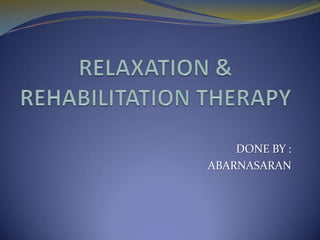
Relaxation & rehabilitation therapy
- 2. contents Relaxation therapy Rehabilitation therapy • • • • • definition Relaxation therapy Purpose of relaxation therapy Easy relaxation techniques precautions • • • • definition Receration therapy process work Recreation therapist do Importance
- 4. definition Relaxation therapy is a broad term used to describe a number of techniques that promote stress reductio n, the elimination of tension throughout the body, and a calm and peaceful state of mind.
- 5. What is Relaxation Therapy? During sleep, the mind can remain active, though the rhythm is slower than that of the mind when awake. Have you ever slept for a full night, but awoke still feeling tired? When the mind is active, sleep is not always restful. The aim of relaxation therapy is to quiet the mind; to allow thoughts to flow in a smooth, level rhythm, and induce the relaxation response. This mental quiet allows for rest and rejuvenation that does not always occur, even during sleep. Relaxation therapy does not attempt to empty the mind, since it is not possible to think of nothing. In relaxation, we focus the mind, and relax both mind and body.
- 6. Purpose of relaxation therapy Relaxation therapy techniques calm the body and provide a natural cure for symptoms of stress and anxiety by inducing the relaxation response - the opposite of the body's stress response.
- 7. Easy Relaxation Techniques Progressive Relaxation - progressively tensing and then relaxing muscle groups - by progressive, I mean one muscle group after another... the relaxation progresses through the body. Passive progressive relaxation is the act of relaxing muscles progressively without tensing them first. If you are already very tense, this method might be best (tightening up already-tight muscles can cause muscle cramping). Physical Techniques - includes progressive muscle relaxation; also stretching, yoga, tai chi, pilates and other physical techniques. Visualization - visualizing something for relaxation or making positive changes, such as picturing in your mind a relaxing scene.
- 8. Guided Imagery - the process of being guided through calming or helpful mental images, such as calming scenes, the healing process, or positive changes. Autogenics - imagining that your limbs are warm and heavy, your heart rate is slow and steady, and your forehead is cool. Meditation - focusing the mind on a word, phrase, or idea and letting go of other thoughts with an attitude of passive acceptance for relaxation or making positive changes. Sensory - experiencing or imagining the sensations of sight, sound, smell, taste, and/or touch. Deep breathing - breathing slowly and regularly and taking sufficiently deep breaths. Other methods - exercise, massage, hypnosis, self-hypnosis, crafts, hobbies, dance, music, conscious mental rest, artwork, walking..... etc.
- 9. precautions Relaxation techniques that involve special exercises or body manipulation (massage and yoga )may not be suitable for individuals with certain health conditions such as arthritis or fibromyalgia. These individuals should consult with their healthcare professionals before engaging in these therapies. Biofeedback may be contraindicated (not recommended) in some individuals who use a pacemaker or other implantable electrical devices. These individuals should inform their therapist before starting treatments, as certain types of biofeedback sensors have the potential to interfere with their use. Relaxation therapy may not be suitable for some unwilling patients. Some relaxation therapies may also be inappropriate for cognitively impaired individuals (e.g., patients with organic brain disease or a traumatic brain injury) depending on their level of functioning.
- 11. DEFINITION According to the American Therapeutic Recreation Association (ATRA), Recreational Therapy means a treatment service designed to restore, remediate and rehabilitate a person’s level of functioning and independence in life activities, to promote health and wellness as well as reduce or eliminate the activity limitations and restrictions to participation in life situations caused by an illness or disabling condition.[1] Recreational Therapy may also be referred to as Therapeutic Recreation or Recreation Therapy.
- 12. Recreation Therapy Process Work Referral to Recreation Therapy The Recreation Therapist conducts an assessment of patient's abilities, interests, needs, desires and identifies barriers. Patient goals are set based on assessment findings. An intervention plan is designed to achieve goals and is part of the overall treatment plan. The Care Plan is put into action. Progress is evaluated to determine how well a patient is meeting their goals and to revise the plan, if necessary. Follow-up.
- 13. What do Recreation Therapists Do A Recreation Therapist utilizes a wide range of treatment and community based interventions and techniques to improve their client’s functioning in the following domains: Physical Cognitive Emotional social leisure needs of their clients
- 14. What do Recreation Therapists Do Recreation Therapists assist clients in developing skills, knowledge and behaviors for daily living and community involvement. The Therapist works with the client and their family to incorporate specific interests and community resources into therapy to achieve optimal outcomes that transfer to their real life environment. The Recreation Therapist restores remediate or rehabilitate in order to improve functioning and independence as well as reduce or eliminate the effects of illness or disability.
- 15. Benefits of Recreation Therapy Recreation Therapy plays an important part in both patient recovery and enhancing quality of life. A qualified Recreation Therapist can assist patients in making leisure choices that are best suited to their needs, interests and strengths. The benefits of Recreation Therapy can be seen in many areas including the physical, mental, social and cultural domains.
- 16. Why is Recreation Therapy so Important Recreation Therapy works to improve individuals’ functioning and keep them as active, healthy and independent as possible in their chosen life pursuits.